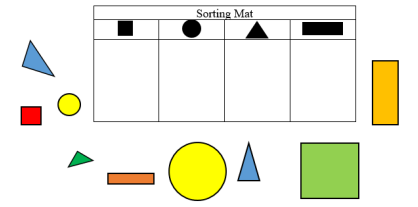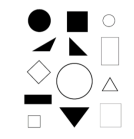Compare two-dimensional figures based on their similarities, differences and positions. Sort two-dimensional figures based on their similarities and differences. Figures are limited to circles, triangles, rectangles and squares.
A triangle can be compared to a rectangle by stating that they both have straight sides, but a triangle has 3 sides and vertices, and a rectangle has 4 sides and vertices.
Instruction includes exploring figures in a variety of sizes and orientations.
| Name |
Description |
| Exploring Machine Learning to Train an AI Model | Students will explore Artificial Intelligence (AI) and Machine Learning (ML) and pretrain a model to recognize and identify objects, including geometric shapes and aircraft. They will used unplugged activities to mimic sorting and classification of the objects using their prior knowledge and then make connections to human learning and Machine Learning. Students will then problem solve and propose solutions using an iterative process to improve the ML model to better recognize the objects. This lesson is an integrated Computer Science, Science and Math lesson designed for students in K-2 to apply math and science content knowledge while exploring and using computational thinking like people in Computer Science careers do. |
| Hide and Seek those Shapes | In this lesson, students will discover the names of different two-dimensional and three-dimensional shapes and their attributes through activities such as playing "Hide and Seek" with shapes and playing "Hot and Cold" to find shapes in the classroom.
|
| Shape Detective | The students will identify and describe shapes (squares, circles, triangles, and rectangles, ) regardless of their orientations or overall size by becoming detectives and going on a "hunt" to find the given shapes. |
| Shape the Shapes | In this lesson, students will learn to identify, describe, and sort two-dimensional shapes (circles, triangles, rectangles, and squares) through music, movement, and hands-on exploration. |
| Shape Up! | In this lesson students will compare two-dimensional shapes to other two- dimensional shapes (circle, square, triangle, and rectangle) and three-dimensional shapes to other three-dimensional shapes (cone, cylinder, sphere, cube) by differentiating them according to attributes. Students describe attributes of shapes by exploring real world objects. |
| Where's that shape? Where am I? | The lesson focus will be a kinesthetic approach to understanding relative positions in the environment. The lesson begins with a critical input experience, as students move around their surrounding, looking for shapes around them. Basic shapes include circle, square, triangle, rectangle. Students will explore shapes in the real world setting. As the lesson progresses, students will learn to describe the position of objects in relation to their own bodies using positional language such as: left/right, in front of/behind, apart and above/below. The lesson will be followed by guided instruction portion using hands-on manipulatives to transfer learned skills. The learning sequence will conclude with an informal assessment of student understanding. |
| Every Group Counts! | The students will be working in whole group, small group and individually to discover measurable attributes of objects and sort the objects into categories. Students will also count and compare the number of objects in each category. |
| Shape Hunt | Students will go on a shape hunt in the classroom or designated area. During the shape hunt, students will find real-world objects that can be modeled by two- and three-dimensional figures. After the shape hunt, students will use Timed-Pair-Share to explain to peers what objects they found and their relative positions. |
| Sorting It All Out | In this lesson, kindergarten students will learn to sort objects familiar to them by different attributes. They will justify their decisions for classification when objects have more than one similar characteristic. |
| Name |
Description |
| Farm Baby Rescue Part 1: Up and Down Positions | Relative positions include up and down, top and bottom, over, on, and under, and above and below. Learn different types of up and down positions to rescue eight chicks in this farm-themed, interactive tutorial. |
| The Search for Shapes: Recognizing Rectangles and Squares | Identify and name rectangles and squares based on their defining attributes, even if they have different sizes or positions. Join King Geo and his scout, Quad, as they search for rectangles and squares in this interactive tutorial.
This is part of a series on the defining attributes of shapes. Click the links below.
|
| The Search for Shapes: Tracking Triangles | Track down triangles based on their defining attributes for King Geo in this interactive tutorial. Learn what makes a triangle a triangle.
This is part of a series on the defining attributes of shapes. Click the links below.
|
| Briana's Shape Playground | Learn how to identify the similarities and differences in the number of sides of two-dimensional shapes in this interactive tutorial. |
| Name |
Description |
| Farm Baby Rescue Part 1: Up and Down Positions: | Relative positions include up and down, top and bottom, over, on, and under, and above and below. Learn different types of up and down positions to rescue eight chicks in this farm-themed, interactive tutorial. |
| The Search for Shapes: Recognizing Rectangles and Squares: | Identify and name rectangles and squares based on their defining attributes, even if they have different sizes or positions. Join King Geo and his scout, Quad, as they search for rectangles and squares in this interactive tutorial.
This is part of a series on the defining attributes of shapes. Click the links below.
|
| The Search for Shapes: Tracking Triangles: | Track down triangles based on their defining attributes for King Geo in this interactive tutorial. Learn what makes a triangle a triangle.
This is part of a series on the defining attributes of shapes. Click the links below.
|
| Briana's Shape Playground: | Learn how to identify the similarities and differences in the number of sides of two-dimensional shapes in this interactive tutorial. |





